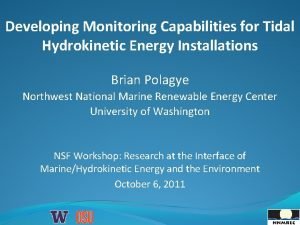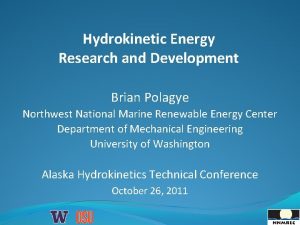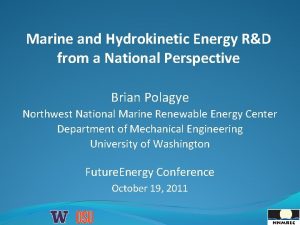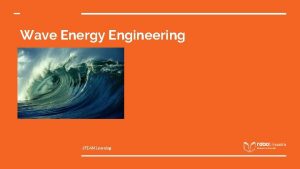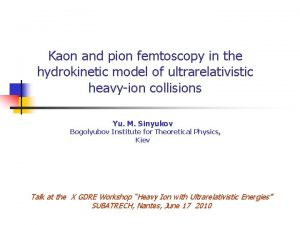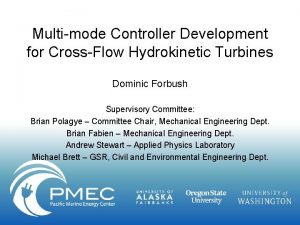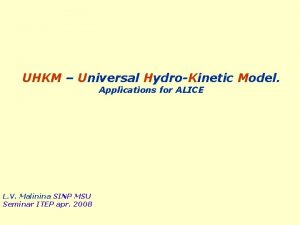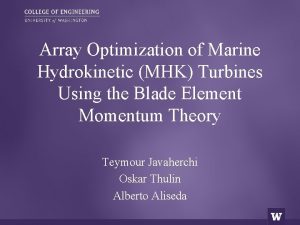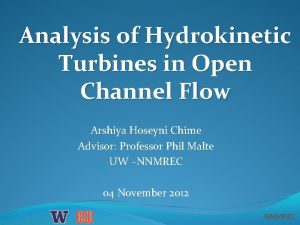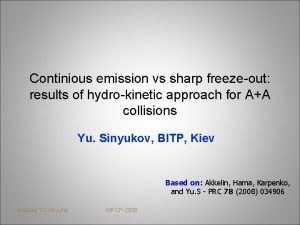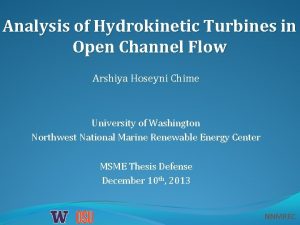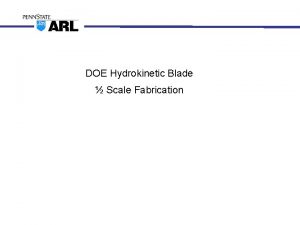HYDROKINETIC ENERGY INTRODUCTION q Hydrokinetics is the study













- Slides: 13

HYDROKINETIC ENERGY

INTRODUCTION q. Hydrokinetics is the study and development of energy harnessing from the natural power of water movement: waves, tidal streams, natural flow of rivers and underwater ocean currents. q. Hydrokinetic technologies produce renewable electricity by harnessing the kinetic energy of a body of water, the energy that results from its motion. q. Since water is 832 times denser than air, our tides, waves, ocean currents, and free-flowing rivers represent an untapped, powerful, highly-concentrated and clean energy resource–Estimates suggest that the amount of energy that could feasibly be captured from U. S. waves, tides and river currents is enough to power over 67 million homes.

WHY HYDROKINETIC ENERGY ? q Hydroelectric power stations result in submersion of extensive areas upstream of the dams, destroying biologically rich and productive lowland riverine valley forests, marshland grasslands. q The loss of land is often exacerbated by habitat fragmentation of surrounding areas caused by the reservoir. q. Hydroelectric projects can be disruptive to surrounding aquatic ecosystems both upstream and downstream of the plant site. q For instance, studies have shown that dams along the Atlantic and Pacific coasts of North America have reduced salmon populations

RESOURCES ØThere a number of types of water resources from which it is possible to generate electricity from kinetic energy. Ø Capturing the energy contained in near and off-shore waves is thought to have the greatest energy production potential amongst these hydrokinetic options. Ø The rise and fall of ocean waves is driven by winds and influenced by oceanic geology. Ø The promise of waves as a power source comes from both sheer resource availability and a relatively advanced technological development status.

TECHNOLOGY WAVE ENERGY CONVERTERS q wave energy converters (wecs) include wave energy of devices, which include qoscillating water column , q point absorbers , q. Attenuators q over toppings devices. ROTATING DEVICE q. There include the windmill type devices

Oscillating water column Point Absorber q. It uses the wave energy from all direction at a simple point by using the vertical motion of the waves to acts as a pump. q. This pressurizes the sea water or an internal fluid that drives a turbine. q. Waves enter & exit a partially submerged collector causing the collector to rise and fall. q The changing water level cause the trapped air in the device above the water to act as a turbine producing electricity.

q There are long jointed floating devices that are aligned parallel to the waves & generate electricity by riding the wave q. The device is anchored at one end and utilizes passing waves to set each section into rotational motion. q. This pressurizes a hydraulic piston that turns the generator. q A floating reservoir is formed as the wave break over the device. q The reservoir heater head of water, a water level higher than that of the surrounding ocean surface. q. This generates the pressure required to turn a turbine.

ROTATING DEVICE q. THERE INCLUDE THE WIND MILL TYPE ALREADY IN USE TODAY. q THE ROTOR TURNS WITH THE CURRENT , CREATING ROTATIONAL ENERGY BY A GENERATOR.

Potential Environmental Impacts Of Hydrokinetic Technologies And Mitigation Measures Potential Mitigation Measures Environmental Issue Potential Impacts Alteration of currents and waves Reduced velocities and wave heights may affect water mixing, sediment and plankton transport, and bottom and coastal habitats Alteration of substrates and sediment transport and deposition Installation may disturb sediments, possibly degrading water quality. Reduction of current velocities or wave heights during operation may alter sediment scour and deposition Avoid siting in areas with contaminated sediments. Use installation techniques that minimize sediment disturbance. Streamline shapes and reduce size of non-generating structures. Installation will displace bottom-dwelling organisms. Changes in currents, waves and sediment transport may alter plant and animal habitats Avoid siting in sensitive areas. Minimize disruption by sub-surface drilling/ boring or burying cables in narrow trenches. Minimize footprint of anchors Noise from pile-driving and other installation activities could disrupt animal behavior Use sound insulation during installation and for generating devices. Avoid sensitive areas and/or seasons. Use acoustic deterrent devices Electromagnetic fields Accidental leaks of hydraulic leaks or erosion of coatings to control biofouling may have toxic effects on organisms Avoid siting in critical migratory paths. Use shielding to prevent leakage of electric current and reduce electromagnetic fields Chemical toxicity New structures may attract animals, affect fishing, create roosting/haul out sites, cause entanglement, or constitute a barrier to migrations Use non-toxic paints and oils, including use of water lubricated devices. Use non-biocidal foulrelease coatings. Mechanical removal of biofouling organisms Organisms may collide with project structures. Diode strike or screen impingement may cause mortality Avoid siting in sensitive areas. Space individual units to allow passage. Use thick, taut mooring lines. Minimize horizontal surfaces above waterline and attractive lighting to minimize interactions with pinnipeds and birds May change temperature and water quality in surface water. Biocides and heat exchange metals could cause contamination. Losses of aquatic animals to entrainment, Avoid siting in sensitive areas. Use discharges for aquaculture, desalination, and agriculture. Minimize intake velocities. Optimize discharge locations. Employ intake screens Alteration of benthic habitats Noise Interference with animal movements and migrations Impacts of ocean thermal energy conversions (OTEC) Avoid siting in sensitive areas. Streamline shapes and reduce size of non-generating structures. Optimize spacing between units to minimize far-field charges

FACILITIES FOR HYDROKINETIC ENERGY q. The deployment of hydrokinetic energy would be facilitated by: üAppropriation of adequate government funding for research, development and deployment of pilot devices. Although Congress has authorized increased funding for hydrokinetic energy in recent years, sufficient funds must be both authorized and appropriated in order for researchers to receive anything; üProvision of dedicated funding for site-by-site research and modeling to evaluate environmental impacts; üSupportive federal economic and energy policies, such as loans or tax credits for hydrokinetic energy development, similar to those for wind and solar energy production and investment; and a federal renewable electricity standard to create demand a secure market for additional renewable energy capacity; üReevaluation of the regulatory process to assist timely project development, while giving appropriate attention to environmental and community safeguards; üResolution of the permitting and licensing jurisdiction conflict in which claims to project approval powers have been made by different federal, state and municipal agencies. üIncreased discussion and collaboration among public and private entities including the electricity industry, research engineers, aquatic scientists, environmentalists and community stakeholders

FACILITIES IN INDIA • India, owing to its huge water resources, can have a lot of potential for hydrokinetic energy. However a lot of research into the topic is required. • Emerging Energies Pvt. Ltd has successfully signed the implementation agreement for a 500 KW hydrokinetic project for Northern Punjab • Centre for Environment and Development (CED) Chairman V. K. Damodaran said that the State of Kerala, home to 44 rivers, lagoons and backwaters, had immense potential in tapping hydrokinetic energy, an emerging clean energy resource that harnesses energy from natural flowing water

ROADS AHEAD q. Initiate at the grass root levels awareness about the potential benefits of Hydrokinetic energy by creating models(which we are already working on), charts and present it before the general public. q. Developing small scale indigenous projects for harnessing power for running irrigation pumps or other agricultural equipments; at least on an experimental scale q. Hydrokinetic energy being environment friendly, schools and colleges can be encouraged to take up investigatory projects on the topic. q. In short, being the change we want to see in the world…………

THANK YOU
 Energy energy transfer and general energy analysis
Energy energy transfer and general energy analysis Energy energy transfer and general energy analysis
Energy energy transfer and general energy analysis Hình ảnh bộ gõ cơ thể búng tay
Hình ảnh bộ gõ cơ thể búng tay Bổ thể
Bổ thể Tỉ lệ cơ thể trẻ em
Tỉ lệ cơ thể trẻ em Chó sói
Chó sói Chụp tư thế worms-breton
Chụp tư thế worms-breton Hát lên người ơi
Hát lên người ơi Môn thể thao bắt đầu bằng chữ đua
Môn thể thao bắt đầu bằng chữ đua Thế nào là hệ số cao nhất
Thế nào là hệ số cao nhất Các châu lục và đại dương trên thế giới
Các châu lục và đại dương trên thế giới Cong thức tính động năng
Cong thức tính động năng Trời xanh đây là của chúng ta thể thơ
Trời xanh đây là của chúng ta thể thơ













